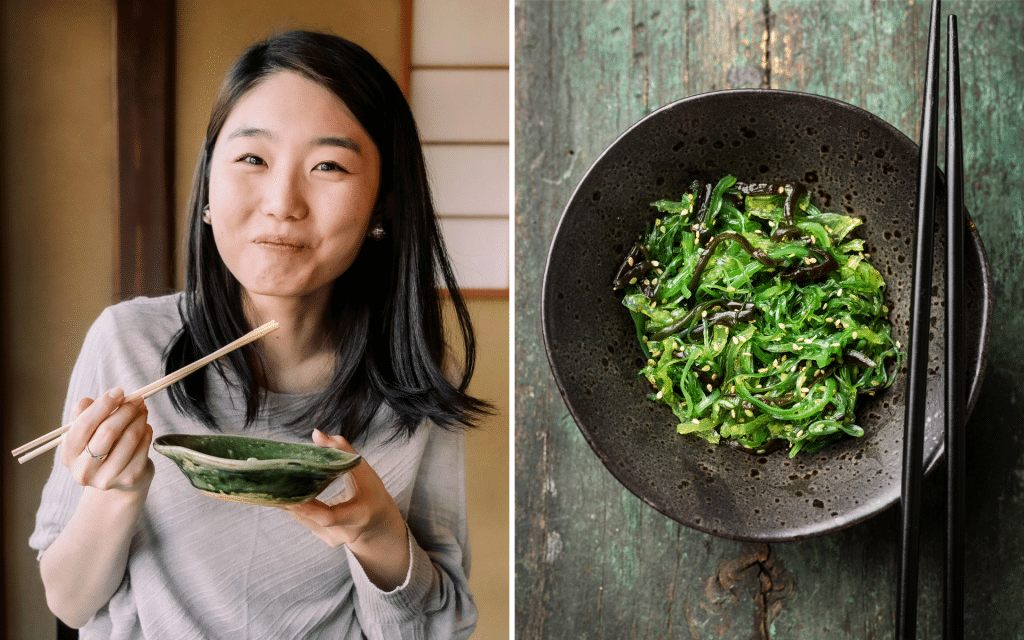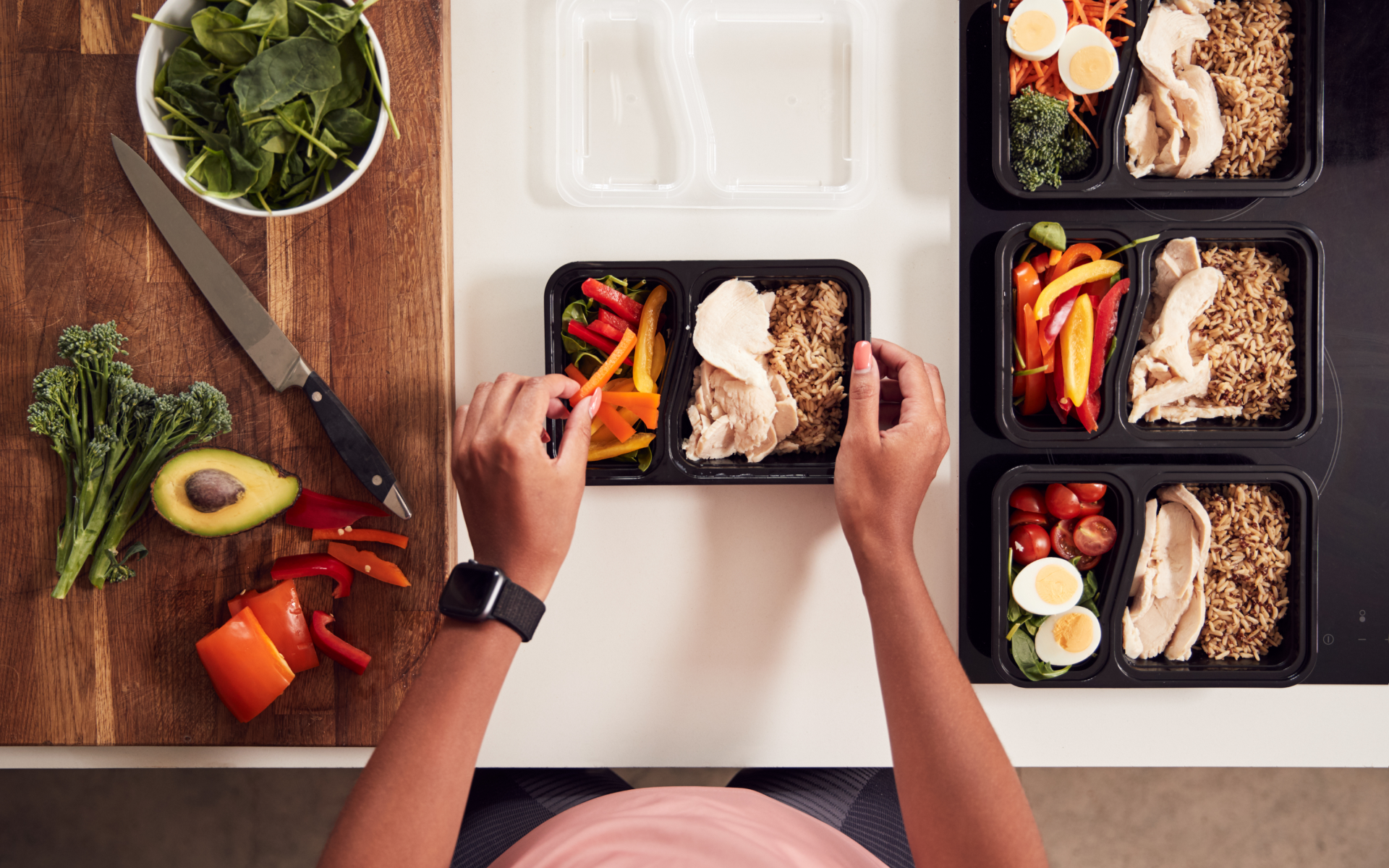Seaweed is used in cuisines all over the world, but it is most popular in Asian countries such as Japan, China, and Korea. It’s a type of edible plant that grows in the sea and comes in different colors including red, green, and brown.
Also known as sea vegetables, these plants are used to make salads, soups, stews, sushi rolls, and smoothies. Seaweed is very nutritious and just like other vegetables, it is a rich source of vitamins, minerals, and fiber. We take a closer look at the science-backed seaweed salad benefits and possible side effects.
Benefits of Seaweed Salad
Seaweed is gaining popularity for a number of reasons, including that it is both versatile and nutritious. There are many different types of seaweed, including:
- Wakame
- Arme
- Dulse
- Noru
- Kemp
- Sea palm
- Irish Moss
- Blue-green algae such as spirulina
These types of seaweed have different tastes and their nutritional profiles differ slightly. Wakame is commonly used to make seaweed salad.
Here are the science-backed seaweed benefits and side effects:
Good Source of Nutrients and Minerals
Eating seaweed is a great way to get a lot of nutrients without consuming too many calories.
Wakame seaweed salad nutrition facts per 100 grams (1)
- Calories: 45
- Protein: 3.03 grams
- Carbohydrates: 9.14 grams
- Fiber: 0.5 grams
- Fat: 0.64 grams
- Sugars: 0.65 grams
- Magnesium: 107 milligrams
- Calcium: 150 milligrams
- Phosphorus: 80 milligrams
- Iron: 2.18 milligrams
- Vitamin E: 1 milligram
Seaweed is generally a potent source of protein, carbohydrates, fibers, and polyunsaturated lipids such as omega-3 (2). It also contains minerals such as selenium, iron, calcium, magnesium, potassium, sodium, phosphorus, manganese and zinc (3).
Vitamins found in sea vegetables include A, B12, E, C, and K (3). Some seaweed types such as sea lettuce (Ulva lactuca) and hypnea contain all 9 essential amino acids (amino acids that must be obtained from the diet as they cannot be synthesized in the body) (4). So, if you’re trying to cut back on animal protein, seaweed is a great alternative.
Supports Thyroid Function
The thyroid is a butterfly shaped gland that is found in your neck that produces thyroid hormones. These hormones are responsible for the regulation of weight, internal temperature, metabolism, repair of damaged cells and growth (5). Iodine is required to produce thyroid hormone. As iodine cannot be synthesized by the body, it has to be obtained from the diet.
Seaweed is arguably the best dietary source of iodine. The iodine content however varies depending on the type of seaweed. Below are the estimated average iodine content of 3 different types of dried sea vegetables (6):
- Kombu: 2523.5 mg/kg
- Nori:36.9 mg/kg
- Wakame: 139.7 mg/kg
If you don’t have enough iodine, your body won’t be able to produce enough thyroid hormone. This may result in symptoms such as fatigue, neck swelling and weight fluctuations. In the case of severe iodine deficiency, a person may develop hypothyroidism or goiter. Interestingly, iodine deficiency is considered one of the most important preventable causes of brain damage throughout the world (7).
Is a Potent Source of Antioxidants
Antioxidants are molecules that help prevent or slow damage to cells caused by free radicals. When there is an imbalance of free radicals and antioxidants in the body, this is referred to as oxidative stress. Overproduction of free radicals can eventually contribute to chronic diseases such as cancer, atherosclerosis, diabetes, arthritis, stroke, Parkinson’s, and heart diseases (8).
Seaweed contains an abundance of antioxidants including vitamins A, C, E, and riboflavin and phytochemicals such as carotenoids. All these can help protect cells from damage caused by oxidative stress (9).
One seaweed carotenoid that has sparked a great deal of interest and has been thoroughly researched is fucoxanthin. Fucoxanthin is mainly found in the brown algae, wakame, that is often used to prepare seaweed salad. It is believed to be 13.5 times more powerful than vitamin E as a free radical scavenger (10).
In addition, fucoxanthin has been found to protect cell membranes better than vitamin A (11). Unfortunately, this antioxidant is not well absorbed in the body, but consuming it with fat may improve its absorption (12).
Helps with Weight Loss
Sea vegetables are rich in fiber, so they’re good for those on a weight loss journey or anyone who wants to increase their fiber intake. The fiber isn’t absorbed or used by the body as energy, but it supports beneficial gut bacteria and helps promote regular bowel movements. Fiber also helps slow gastric emptying. This may increase satiety so you don’t get hungry as soon as you would after eating a low-fiber meal (13).
Seaweed may also possess anti-obesity properties. Research has suggested that compounds such as fucoxanthin and fucoidans that are found in seaweed may inhibit lipid absorption and metabolism. Fucoxanthin may inhibit adipocyte differentiation. A different compound called alginates, which comprises 40% of dry weight in brown seaweeds, may increase satiety and reduce calorie intake (14).
If you wish to free yourself from all the extra pounds that have been weighing you down for way too long, start using the BetterMe: Health Coaching app and overhaul your entire life!
Supports Gut Health
Next on the seaweed salad nutrition benefit list is that it supports gut health. As previously mentioned, sea vegetables are a potent source of fiber. The fiber in seaweed helps feed friendly gut bacteria (15). An imbalance of good and bad gut bacteria may contribute to diseases and uncomfortable symptoms.
In addition, carbohydrates in brown seaweed known as sulfated polysaccharides may increase the growth of friendly gut bacteria. They may also increase the production of short-chain fatty acids by gut bacteria that support and nourish the cells lining the gut (16).
May Lower the Risk of Cardiovascular Disease
Heart disease is the number one cause of death globally. Fiber-rich foods such as marine algae may help lower blood cholesterol levels (17). Obesity, a diet rich in saturated fats, smoking, drinking alcohol, and physical inactivity all put you at risk of unhealthy cholesterol levels.
Seaweed also contains fiber, peptides, and carotenoids, all of which may lower serum cholesterol and blood pressure. A study by the Japanese Public Health center found the consumption of seaweed to be inversely related to the risk of stroke (18).
May Reduce Your Risk of Type 2 Diabetes Mellitus
Type 2 diabetes is a disease caused by an impairment in the regulation of blood glucose. It is characterized by high blood sugar levels, insufficient insulin production, and insulin resistance. Risk factors include being overweight, unhealthy eating, a sedentary lifestyle, or a family history of type 2 diabetes.
Seaweed is a fiber-rich food and this may help regulate blood glucose levels (13). In a small study, 9 women and 11 men with diabetes were allocated to either a seaweed supplementation group or control group. At the end of the 4-week study, it was concluded that seaweed improves glycemic control, lowers blood lipids, and increases antioxidant enzyme activities (19).
Other studies have also found that incorporating seaweed into the diet may have antidiabetic effects (20) (21). However, more research is required on the effect of seaweed supplementation.
May Help Reduce Your Risk of Cancer
Seaweed may also help lower your risk of certain cancers such as prostate, colon, and breast. Research has indicated that seaweed and seaweed-derived products may have anti-cancer activities via mechanisms such as the inhibition of cancer cell invasion, growth, and metastases and the induction of apoptosis (22). A 2014 review described the mechanisms by which seaweed may have potential as anti-cancer agents in breast and colorectal cancer (23).
Another review looked at the anti-cancer activity of red seaweed. The study found that terpenes, polyphenols, and polysaccharides are the major contributors of anti-cancer activity in red seaweed. Poryphyran also displays anti-cancer activity as it is toxic for cancer cells and induces cell death. Carrageenan inhibits tumor growth by arresting the cell cycles of tumors at specific phases (24).
Most studies to date on the anti-cancer effects of seaweed have been done in test tubes, so it isn’t fully understood whether or how supplementation with seaweed or including it in the diet may affect cancer risk in humans.
Read more: How to Build a Healthy Dinner Plate, According to Experts
Side Effects of Too Much Seaweed Salad
Eating small but regular amounts of seaweed is completely safe. However, there are a few dangers that come with eating too much seaweed. There are 2 major brown seaweed side effects:
- High Iodine Levels
While iodine is important for thyroid function, too much can be harmful. An overload of iodine intake may precipitate goiter, hypothyroidism, hyperthyroidism, or thyroid autoimmunity (25). However, most healthy people are able to tolerate moderately high intakes quite well.
In Japan, the daily average intake of iodine is approximately 1,000 to 3,000 micrograms (26) This is way over the tolerable limit of iodine, which is 1,100 micrograms (27). Therefore, eating seaweed poses a risk if consumed every day and in high amounts. Ironically, the high iodine intake is sometimes regarded as one of the reasons why the Japanese people are among the healthiest in the world.
If you think you may be consuming too much iodine and experience symptoms such as neck swelling or weight fluctuations, talk to your physician and reduce your consumption of iodine-rich foods. Also, if you have a thyroid condition or are taking any thyroid medication, consult your doctor before adding seaweed to your diet.
- Heavy Metal Load
Seaweed can rapidly accumulate high concentrations of metals such as cadmium, copper (III), and copper (IV). Even in trace amounts, metals such as lead, mercury, and cadmium can be toxic. Heavy metals are usually stored in fatty tissues and organs and may have adverse effects on the central nervous system (28).
A 2017 study analyzing metal load in seaweeds from Europe and Asia found that the levels of aluminum, lead, and cadmium in 4 grams of seaweed didn’t pose any health risk (29). However, if you regularly consume seaweed in large amounts, there is potential for metals to accumulate in your body.
Seaweed Salad Recipes
Making seaweed salad is just as easy as making tomato salad. Common ingredients that are added to the seaweed include rice vinegar, sesame oil, soy sauce, ginger juice, and scallions. However, as it’s a salad, you can get creative with the ingredients in your pantry and see how it turns out.
Below are 2 simple ways you can prepare a seaweed salad:
Japanese Seaweed Salad (30)
You can replace the wakame seaweed with a type you prefer or use more than one kind of seaweed.
Ingredients
- 50 grams (1.7 ounces) dried wakame seaweed
- 3 tablespoons soy sauce
- 1 tablespoon rice vinegar
- 1 tablespoon mirin
- 1 teaspoon sugar
- 1 teaspoon ginger, grated
- ½ teaspoon garlic, grated
- 1 tablespoon toasted sesame oil
- ¼ teaspoon red pepper flakes
- 1 baby cucumber, thinly sliced
- ½ teaspoon toasted white sesame seeds
- ½ teaspoon black sesame seeds
Directions
- Put the dried wakame seaweed in a bowl, add water, and let it sit for 10 minutes to rehydrate. The rehydrated seaweed should be softer and lighter in color.
- In a different bowl, mix the rice vinegar, soy sauce, ginger, garlic, sugar, mirin, sesame oil, and pepper flakes. Set aside.
- Once the wakame seaweed is rehydrated, strain it in a colander and rinse. Ensure you remove as much moisture as you can, squeezing the wakame if necessary.
- Add the seaweed, cucumber slices, and sesame seeds to the bowl with the dressing. Toss to combine.
- Cover and place in the refrigerator for 30 to 60 minutes.
- When ready, sprinkle with sesame seeds. Enjoy!
Servings: 4
Nutritional info: 62 calories, 5.8g carbs, 1.6g protein, 3.7g fat
The BetterMe: Health Coaching app will provide you with a host of fat-frying fitness routines that’ll scare the extra pounds away and turn your body into a masterpiece! Get your life moving in the right direction with BetterMe!
Spicy Kale and Seaweed Salad (31)
Instead of the conventional Japanese seaweed salad, you can make this spicy kale version. However, if you’re on a diet, take a quarter or half a serving instead of a full serving.
Ingredients
- 4 cups canola oil
- 1 cup shallots, thinly sliced
- 1 tbsp aged balsamic
- 1 tbsp ponzu
- 1 tbsp toasted sesame oil
- 8 oz baby kale, sliced
- 2 cups toasted seaweed, sliced then cut in half
- 1 1/2 tbsp sesame seeds
- 1 tbsp fresh chili, thinly sliced
Directions
- Heat the canola oil in a large saucepan.
- Add the shallots to the oil and cook until they turn golden brown.
- Remove the shallots from the oil and transfer to a paper towel-lined plate or tray. Allow them to cool.
- To prepare the dressing, whisk the sesame oil, ponzu, and balsamic together and then put aside.
- In a bowl, mix the kale, seaweed, and shallots. Toss to combine.
- Add the chilli and sesame seeds.
Servings: 4
Nutritional info: 2,103 calories, 230 g fat, 15 g carbs, 5g protein
Read more: Low-Potassium Foods to Eat and What to Avoid
Is It OK to Eat Seaweed Salad Every Day?
Seaweed salad can be a healthy addition to your diet as it’s packed with vitamins, minerals, and antioxidants, including iodine, calcium, and vitamins A, C, E, and K. However, it’s best to consume it in moderation and as part of a varied diet.
There are a few considerations you should keep in mind:
- Iodine Content: Seaweed is a rich source of iodine, which is essential for thyroid function. However, consuming too much iodine can lead to thyroid issues, so moderation is key.
- Sodium Levels: Some seaweed salads can be high in sodium, particularly if they’re prepared with soy sauce or other salty ingredients. It’s important to monitor your sodium intake to maintain heart health.
- Heavy Metals: Seaweed can absorb heavy metals from the ocean, such as arsenic and lead. While the levels are generally low, it’s wise to vary your diet to minimize potential risks.
The Bottom Line
Seaweed salad is mainly served as a starter. It also makes a perfect side dish for many meals, including Thanksgiving turkey or chicken. Seaweed is one of the best sources of dietary iodine and contains many minerals, so it has great health benefits. Too much can be dangerous, so make sure you consume small to moderate amounts of seaweed salad.
DISCLAIMER:
This article is intended for general informational purposes only and does not serve to address individual circumstances. It is not a substitute for professional advice or help and should not be relied on for making any kind of decision-making. Any action taken as a direct or indirect result of the information in this article is entirely at your own risk and is your sole responsibility.
BetterMe, its content staff, and its medical advisors accept no responsibility for inaccuracies, errors, misstatements, inconsistencies, or omissions and specifically disclaim any liability, loss or risk, personal, professional or otherwise, which may be incurred as a consequence, directly or indirectly, of the use and/or application of any content.
You should always seek the advice of your physician or other qualified health provider with any questions you may have regarding a medical condition or your specific situation. Never disregard professional medical advice or delay seeking it because of BetterMe content. If you suspect or think you may have a medical emergency, call your doctor.
SOURCES:
- Seaweed, wakame, raw (2019,usda.gov)
- Phycochemical Constituents and Biological Activities of Fucus spp. (2018,mdpi.com)
- Algae as nutritional and functional food sources: revisiting our understanding (2016,nih.gov)
- Nutritional evaluation of some subtropical red and green seaweeds: Part I — proximate composition, amino acid profiles and some physico-chemical properties (2000,sciencedirect.com)
- Physiology, Thyroid Hormone (2023,nih.gov)
- Analysis of iodine content in seaweed by GC-ECD and estimation of iodine intake (2014,sciencedirect.com)
- Iodine and thyroid function (2014,nih.gov)
- Free radicals, antioxidants and functional foods: Impact on human health (2010,nih.gov)
- Antioxidant and cytotoxic activities of three species of tropical seaweeds (2015,bmccomplementmedtherapies.biomedcentral.com)
- Biosynthetic Pathway and Health Benefits of Fucoxanthin, an Algae-Specific Xanthophyll in Brown Seaweeds (2013,mdpi.com)
- QUENCHING MECHANISMS AND KINETICS OF CAROTENOIDS IN RIBOFLAVIN PHOTOSENSITIZED SINGLET OXYGEN OXIDATION OF VITAMIN D2 (2007,onlinelibrary.wiley.com)
- Fucoxanthin, a Marine Carotenoid Present in Brown Seaweeds and Diatoms: Metabolism and Bioactivities Relevant to Human Health (2011,mdpi.com)
- Emergent Sources of Prebiotics: Seaweeds and Microalgae (2016,mdpi.com)
- Marine Algae as a Potential Source for Anti-Obesity Agents (2016,mdpi.com)
- Dietary fiber and prebiotics and the gastrointestinal microbiota (2016,tandfonline.com)
- Digestibility of sulfated polysaccharide from the brown seaweed Ascophyllum nodosum and its effect on the human gut microbiota in vitro (2018,nih.gov)
- Composition, nutritional aspects and effect on serum parameters of marine algae Ulva rigida (2010,nih.gov)
- Seaweed Intake and Risk of Cardiovascular Disease: The Circulatory Risk in Communities Study (CIRCS) (2021,jstage.jst.go.jp)
- Effects of seaweed supplementation on blood glucose concentration, lipid profile, and antioxidant enzyme activities in patients with type 2 diabetes mellitus (2008,nih.gov)
- Anti-hyperglycemic and antigenotoxic potential of Ulva rigida ethanolic extract in the experimental diabetes mellitus (2009,nih.gov)
- Evaluation of antidiabetic, antioxidant and vasoprotective effects of Posidonia oceanica extract (2008,nih.gov)
- Seaweeds and Cancer Prevention (2018,sciencedirect.com)
- Anticancer Effects of Different Seaweeds on Human Colon and Breast Cancers (2014,mdpi.com)
- Anti-Cancer Activity of Porphyran and Carrageenan from Red Seaweeds (2019,nih.gov)
- Excess iodine intake: sources, assessment, and effects on thyroid function (2019,nih.gov)
- Iodine (2024,nih.gov)
- Assessment of Japanese iodine intake based on seaweed consumption in Japan: A literature-based analysis (2011,thyroidresearchjournal.biomedcentral.com)
- Distribution of metals and metalloids in dried seaweeds and health risk to population in southeastern China (2018,nature.com)
- Metals in edible seaweed (2017,nih.gov)
- Japanese Seaweed Salad (Wakame) (2021,asianinspiredeats.com)










